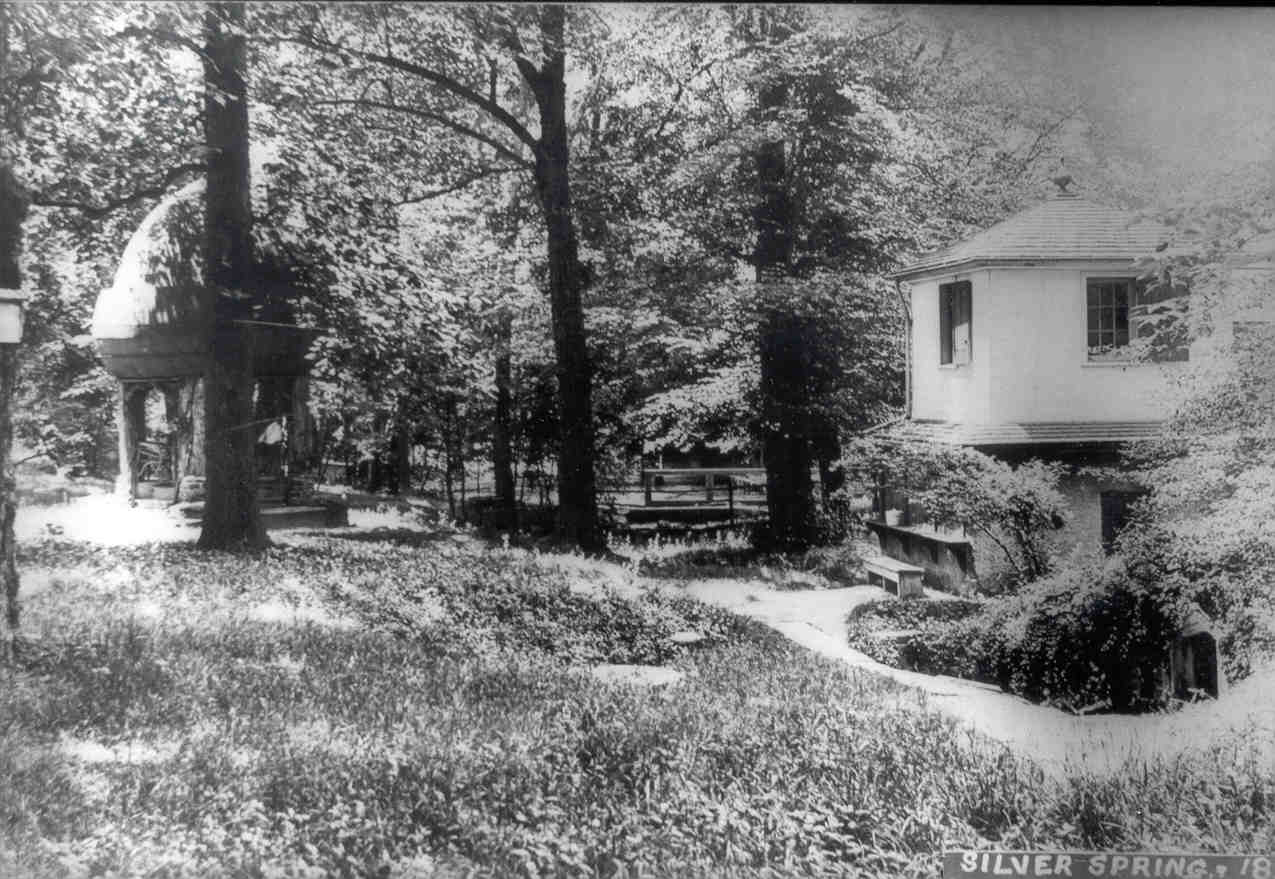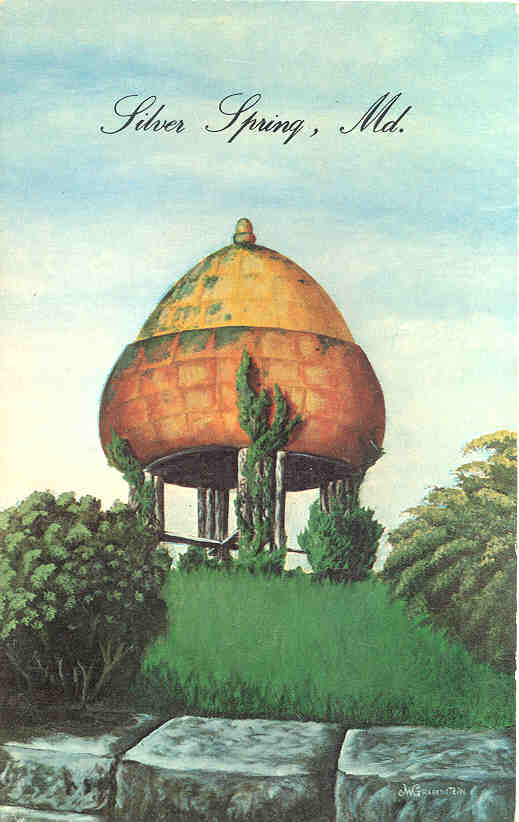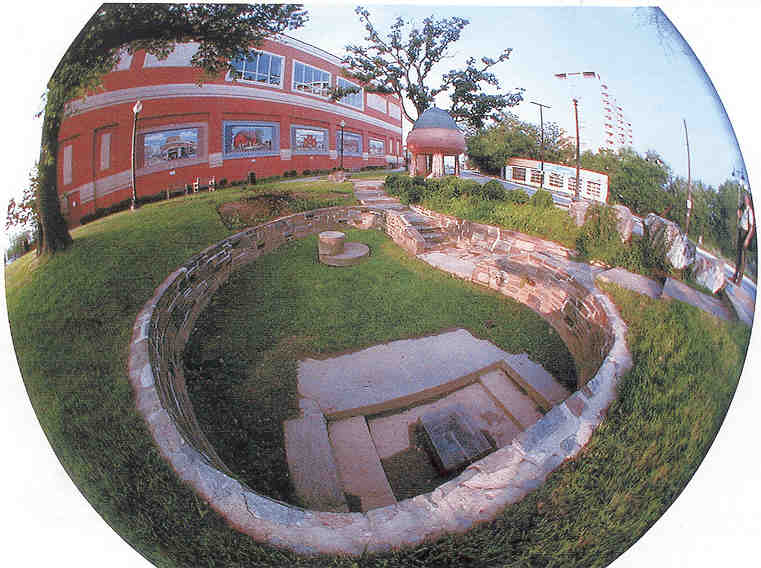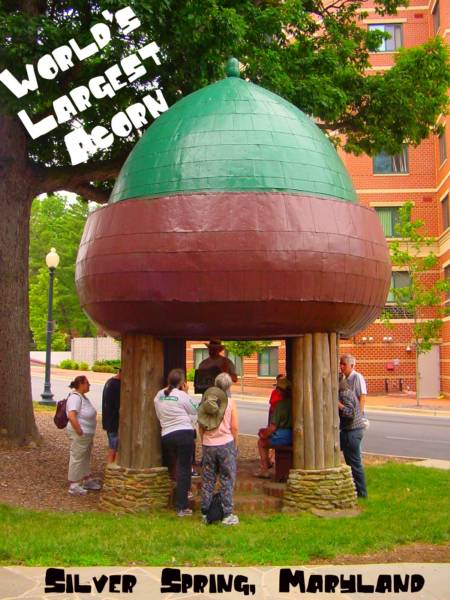Silver Spring: Then & Again
Happy 50th Birthday, Acorn Park!
By Jerry A. McCoy
Silver Spring Voice
May 2005
Memorial Day weekend will mark the 50th anniversary of the dedication of Acorn Park, site of the original "silver" spring after which our community was named. Located at the intersection of East-West Highway (410) and Newell Street, this .12-acre urban park is all that remains of Silver Spring founder Francis Preston Blair, Sr.'s estate and summer home, Silver Spring, constructed in 1842. In 1942 the property was acquired by the Maryland-National Capital Park & Planning Commission and later renovated and formally dedicated on May 28, 1955.
This date was also celebrated as the first "Silver Spring Day." Adopted on May 10, 1955 by the Montgomery County Council, the proclamation declared, "Be it resolved by the County Council for Montgomery County, Maryland, that Saturday, May 28, 1955 and the last May in each succeeding year shall be known as 'Silver Spring Day' in commemoration of the restoration on May 28, 1955 of 'The Silver Spring,' dedicated as an ever-flowing tribute to the men and women responsible for the greatness of Silver Spring, Maryland, and its bright future through civic and community service."
Never heard of "Silver Spring Day?" Not surprising, considering that this decreed day seems to have been all-but-forgotten by time its one-year anniversary rolled around in 1956 when even our then hometown newspaper, The Maryland News, failed to mention it!
Maybe we can change that.
On Saturday, May 28, 2005, the Silver Spring Historical Society invites the community to come to Acorn Park at 10:00 a.m. to celebrate the 50th birthday of Acorn Park and too perhaps revitalize the lapsed Silver Spring Day now that our community's "bright future" has finally arrived. Please attend and reflect on the rich history that the founding of our community embodies. And what a history it is. On the chance that I'll bore some of you who have probably read or heard the story of how the silver spring was discovered dozens of times, the two versions are again worth repeating here for the many new residents to the area (yes, two versions).
At the park's 1955 dedication, Blair Lee III, great, great grandson of Francis Preston Blair, Sr., told the story of the spring's discovery this way. Blair was a newspaper editor from Frankfort, KY who came to Washington in 1830 at the bequest of President Andrew Jackson to edit the Washington Globe, established by friends of Jackson to counteract the city's other newspaper, the National Intelligencer, which opposed the Jackson administration. Having been considering the construction of a country house to escape the "miasma" of summer in Washington, Blair went horseback riding out the Seventh Street Pike (Georgia Avenue) with his daughter, Elizabeth, in 1840.
Elizabeth, Blair's only daughter, was astride a horse named Selim and reading a love letter from a young Naval lieutenant named Samuel Phillips Lee, whom she later married. Not paying attention, Elizabeth was brushed off her mount by a tree limb. Selim took off and, when finally located by father and daughter, was discovered to be drinking from a small spring. In the spring's water was mica sand, and when the sun reflected off the water it sparkled like silvera silver spring. Papa Blair looked around, liked what he saw, and decided he had found the site for his home in the country. The rest, as they say, is history.
So ensconced is this version in the Lee family history that a silhouette of the event's denouement forms the logo of the family's Lee Development Group. If you walk into the Lee Building at the corner of Colesville Road and Georgia Avenue you will see it set into the lobby floorBlair and Elizabeth are standing beside Selim (who perhaps is lapping water from the spring) with all positioned under the sheltering boughs of a presumed oak tree.
Every story has two sides and so it appears does this one. The Blair family had a slightly different version of the spring's discovery. On April 17, 1917, Gist Blair, grandson of Francis Preston Blair, Sr., presented a paper before the Columbia Historical Society titled "Annals of Silver Spring." I'll let Mr. Blair tell the story:
"While riding Selim one day outside the boundary of the District of Columbia, his (Francis Preston Blair, Sr.) horse became frightened and threw his rider and ran away among the thick growth of pines in the valley to the west of the road (Georgia Avenue)He followed his horse into the woods and found him snared by the reins by a bush which had caught the reins dangling, and near the place was a beautiful spring full of white sand and mica which the gush of water from the earth forced into a small column which sparkled as it rose and fell like silver. He was charmed by the spot and purchased the property."
So, was Elizabeth Blair Lee actually there? Unless definitive documentation of the circumstances of this "discovery" exists, preferably in the form of Blair, Sr.'s own testimony, perhaps we will never know. I feel comfortable however in giving due credit to perhaps the true founder of Silver Spring, Selim!
Other than the dowdy Selim Road, which parallels the east side of the CSX/Metro tracks between Burlington Avenue and Sligo Avenue, one would be hard pressed to find any other acknowledgement of our founding horse in downtown Silver Spring. Perhaps a statue is in order, or a least a restaurant named after him (her)? It would be great to hear, "We had a great meal last night a Selim's!"
Besides probably being the only community whose founding should be credited to a horse, Silver Spring is unique in that it has, if not the only acorn-shaped gazebo in the United States, than at least the oldest. Located in Acorn Park (where sadly only two oak trees remain) is an unusual gazebo topped by a giant upturned acorn. Originally constructed ca. 1850 on Blair's Silver Spring estate, the possible builder of this unusual structure has never been publicly credited until now.
The positioning of the gazebo near the spring site is understandable, given the fact that Blair was very proud of his spring and enjoyed showing it off to his important visitors. President Abraham Lincoln reputedly sat under it (until also documented an enticing suburban legend if ever there was one!). In the late 1990s when the gazebo was renovated, four simple benches were constructed and placed in it. These benches replaced earlier ones that had long ago replaced freestanding twig furniture that can be seen in early 20th century photographs of the gazebo.
Numerous times have I sat under the gazebo and contemplated how the visual landscape of Silver Spring must have looked to Francis Preston Blair, Sr. when he sat there over 150 years ago. Many other stories reside in this .12-acre slice of Silver Spring's history. Stop by on May 28th and I'll be happy to tell you about them.






